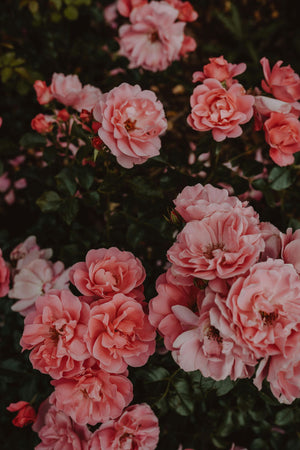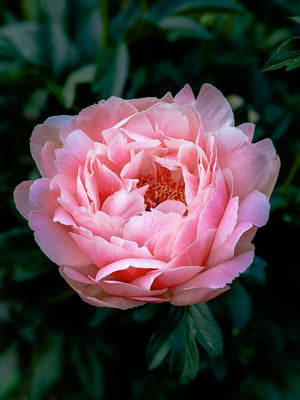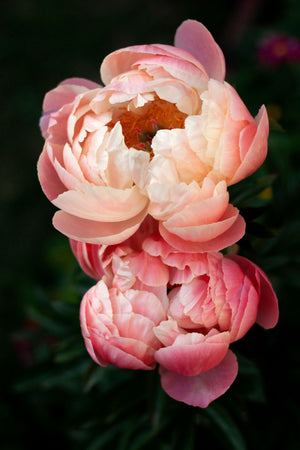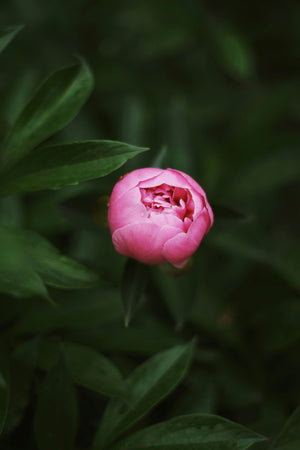The Peony Guide
Peonies, renowned for their lush, full blooms and delightful fragrance, are a staple in many garden landscapes. These elegant perennials bring a touch of timeless beauty and sophistication to any garden. Known for their large, ruffled flowers and lush green foliage, peonies are perfect for adding vibrant color and texture to borders, beds, and cutting gardens. Their blooms come in a wide range of colors, including pink, red, white, and yellow, making them a favorite among gardeners and floral enthusiasts alike. Whether you're looking to create a stunning focal point in your garden or enjoy beautiful cut flowers for arrangements, peonies offer a versatile and enchanting solution. With minimal maintenance requirements and the ability to thrive in various soil types and climates, peonies are a reliable and rewarding addition to any garden. Explore our Peony Guide to learn more about cultivating and caring for these magnificent perennials, and discover how to incorporate them into your garden for lasting beauty and enjoyment.

About
Peonies, belonging to the Paeoniaceae family, are cherished for their lush, extravagant blooms and delightful fragrance. These long-lived perennials are native to Asia, Europe, and Western North America and have been cultivated for centuries for their stunning flowers and ornamental value. Peonies are renowned for their large, ruffled flowers that come in a wide array of colors, including shades of pink, red, white, yellow, and even coral.
There are three main types of peonies: herbaceous peonies, tree peonies, and intersectional (or Itoh) peonies. Herbaceous peonies are the most common type, dying back to the ground each winter and re-emerging in the spring. Tree peonies are woody shrubs that retain their structure year-round and produce larger blooms. Intersectional peonies are a hybrid between herbaceous and tree peonies, combining the best traits of both, including sturdy stems and abundant flowers.
Peonies typically bloom in late spring to early summer, providing a spectacular display of color and fragrance in the garden. Their lush green foliage remains attractive throughout the growing season, adding texture and depth to garden beds and borders even after the blooms have faded. Peonies are also highly valued as cut flowers, often used in bouquets and floral arrangements for their beauty and longevity.
Peonies thrive in well-drained soil and prefer a location with full sun to partial shade. They are relatively low-maintenance once established, requiring minimal watering and care. These hardy perennials can live for decades, often outlasting the gardeners who plant them, making them a treasured addition to any garden.
Explore the diverse world of peonies in our comprehensive guide, where you'll find insights into planting techniques, care practices, and creative ways to incorporate these stunning flowers into your garden. Whether you're enhancing borders, creating cutting gardens, or designing striking focal points, peonies offer endless possibilities for enriching your outdoor space.

Planting
Peonies require specific planting conditions to ensure their successful establishment and flourishing growth. Here are some essential guidelines for planting and caring for peonies:
Soil: Peonies thrive in well-drained, fertile soil with a pH level ranging from 6.5 to 7.0. Prepare the planting site by loosening the soil and incorporating organic matter such as compost or well-rotted manure to improve soil structure and fertility. Avoid planting in heavy clay or waterlogged soil, as this can lead to root rot.
Sunlight: Peonies prefer full sun, requiring at least six hours of direct sunlight per day for optimal blooming. In hotter climates, some afternoon shade can help protect the plants from intense heat, but too much shade can result in fewer blooms.
Watering: Adequate watering is essential during the initial growth stages. After planting, water the peonies deeply to establish strong roots. Maintain consistent soil moisture, particularly during dry periods, but avoid waterlogging, which can lead to root rot. Once established, peonies are relatively drought-tolerant and require less frequent watering.
Spacing: Plant peonies 3 to 4 feet apart, depending on the variety and their mature size. Proper spacing ensures adequate air circulation and reduces the risk of fungal diseases, promoting healthy plant development.
Planting Time: The best time to plant peonies is in the fall, typically from September to November, giving them time to establish roots before winter. Spring planting is also possible, but it may delay blooming until the following year.
Depth: When planting peonies, ensure that the eyes (buds) on the root are positioned 1 to 2 inches below the soil surface. Planting too deeply can hinder blooming. For tree peonies, plant at the same depth they were growing in the container.
Mulching: Apply a thin layer of organic mulch, such as compost or straw, around the base of your peonies to retain moisture, suppress weed growth, and regulate soil temperature. Ensure the mulch is kept a few inches away from the plant stems to prevent moisture-related issues.
By following these planting and care instructions, you can ensure the successful establishment and thriving growth of your peony plants. With proper attention, peonies will bring lush, vibrant blooms and enduring beauty to your garden, enhancing its charm and appeal for years to come.

Care
Peonies require specific care to ensure their optimal growth and health. Here are some general guidelines for the care of peonies:
Watering: During the growing season, provide regular watering to your peony plants. Aim to keep the soil consistently moist but not waterlogged. Water deeply at the base of the plant to encourage deep root growth and to prevent fungal diseases. Peonies are relatively drought-tolerant once established, so adjust watering frequency based on rainfall and weather conditions.
Pruning: Peonies generally require minimal pruning. Remove any dead or damaged leaves as needed to maintain a tidy appearance and to prevent disease. After the flowering period, cut back the spent blooms to encourage energy to be redirected to the roots. In late fall, after the foliage has died back, cut herbaceous peonies to the ground to prevent pests and diseases from overwintering.
Fertilizing: Fertilizing can help boost the growth and blooming of peony plants. Apply a balanced, slow-release fertilizer in early spring when new growth begins and again after the flowering period. Avoid over-fertilizing, as this can lead to excessive foliage growth at the expense of flowers.
Soil and Sunlight: Ensure that peonies are planted in well-drained, fertile soil with a pH level ranging from 6.5 to 7.0. Peonies thrive in full sun but can tolerate partial shade. Provide at least six hours of direct sunlight per day for optimal blooming. Amend heavy clay soils with organic matter to improve drainage.
Mulching: Apply a thin layer of organic mulch around the base of your peony plants to retain moisture, suppress weed growth, and regulate soil temperature. Use materials like compost or straw, ensuring the mulch does not touch the plant stems directly to prevent rot and fungal issues.
Pests and Diseases: Peonies are generally resistant to pests and diseases, but they can occasionally encounter issues such as botrytis blight, powdery mildew, and aphids. Inspect your plants regularly and treat any infestations promptly with appropriate organic or chemical controls.
Staking: Some peony varieties produce large, heavy blooms that may need support to prevent the stems from bending or breaking. Use stakes or peony rings to support the plants, placing them around the peonies in early spring before the stems begin to grow.
Winter Care: In colder climates, protect your peonies from harsh winter conditions by applying a layer of mulch to insulate the roots. Remove any debris from around the plants in the fall to reduce the risk of pests and diseases overwintering in the garden.
Dividing: Herbaceous peonies benefit from occasional division to maintain vigor and prevent overcrowding. Divide the plants every 8-10 years in early fall. Dig up the clump, separate it into smaller sections with at least three to five eyes (buds), and replant them at the same depth as the original plant.
By following these care guidelines, your peony plants will thrive and add lush, vibrant blooms and enduring beauty to your garden for years to come. With their resilience, low maintenance requirements, and stunning flowers, peonies are a valuable addition to any landscape, providing year-round interest and charm.

How To Use
Peonies offer versatility and can be utilized in various ways to enhance your landscape and home. Here are some recommendations based on their characteristics:
Colorful Borders: Use peonies to create vibrant borders in your garden. Plant them along pathways or garden beds to add splashes of color and texture. Their large, showy blooms create a dramatic effect when planted in masses.
Focal Points: Peonies make excellent focal points in garden design. Plant them in prominent locations where their lush, ruffled flowers can be fully appreciated. Use them to draw attention to specific areas, such as entryways, garden corners, or patios.
Cut Flower Arrangements: Peonies are highly valued for their long-lasting blooms and delightful fragrance, making them perfect for cut flower arrangements. Harvest the flowers when they are in bud or just beginning to open and use them in bouquets, centerpieces, or floral displays to bring their beauty indoors.
Mixed Perennial Beds: Incorporate peonies into mixed perennial beds for continuous seasonal interest. Pair them with other early-blooming perennials, summer flowers, and fall foliage plants to create a dynamic and visually appealing garden composition.
Cottage Gardens: Peonies fit perfectly into cottage garden designs, where their informal, natural look blends well with other traditional garden plants. Combine them with roses, foxgloves, and delphiniums for a charming, old-fashioned garden.
Seasonal Displays: Use peonies in seasonal displays to create stunning visual effects. Their diverse color palette allows for beautiful combinations that change with the seasons, adding excitement and variety to your garden.
Containers: While less common, peonies can be grown in large containers. This is especially useful for tree peonies or for creating a movable display. Ensure the containers have good drainage and are large enough to accommodate the plant's root system.
Wedding and Event Decor: Peonies are a favorite in wedding and event decor due to their luxurious appearance and lovely scent. Use them in bridal bouquets, table arrangements, and venue decorations to add a touch of elegance and romance.
Pollinator Gardens: Peonies attract pollinators like bees and butterflies with their vibrant blooms. Plant them alongside other pollinator-friendly plants to support local wildlife and create a thriving ecosystem.
Companion Planting: Peonies pair well with a variety of other plants. Their sturdy stems and large blooms provide a beautiful backdrop for smaller flowers and foliage plants. Consider combining them with irises, daylilies, and ornamental grasses for a balanced and harmonious garden design.
When incorporating peonies into your landscape, consider their growth habits, sunlight requirements, and soil preferences. By choosing the right placement and utilizing their versatile nature, peony plants can enhance the beauty and functionality of your outdoor space, providing year-round interest and stunning blooms.
Conclusion
Peonies are a stunning and versatile addition to any garden landscape. With their lush, full blooms and delightful fragrance, these hardy perennials bring a touch of timeless beauty and sophistication to your outdoor space. Their ease of care and adaptability to various soil types and climates make them a favorite among gardeners of all levels. By adhering to proper planting and maintenance techniques, you can fully harness the potential of peonies to elevate your garden and create a lasting impact.
Whether you seek to create colorful borders, striking focal points, or charming cottage gardens, peonies can fulfill a variety of roles in your landscape design. Plant them individually to showcase their unique beauty, or cluster them together for a dramatic visual display. Peonies’ ability to attract pollinators, provide stunning cut flowers, and contribute to seasonal garden interest adds to their appeal, making them a valuable addition to any garden.
Beyond their ornamental value, peonies contribute to the overall health and beauty of your garden ecosystem by attracting beneficial insects and providing habitat for pollinators. Their low maintenance requirements and long lifespan make them an excellent choice for sustainable gardening. With their enduring beauty, versatility, and ecological benefits, peony plants bring natural allure and elegance to your outdoor environment, enriching your gardening experience and enhancing the overall beauty of your landscape.








